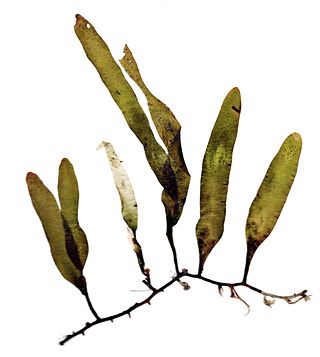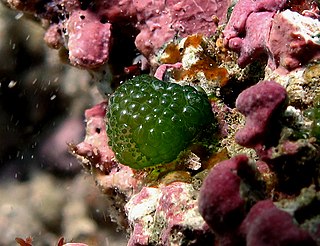
A reef is a ridge or shoal of rock, coral or similar relatively stable material, lying beneath the surface of a natural body of water. Many reefs result from natural, abiotic (non-living) processes such as deposition of sand or wave erosion planing down rock outcrops. However, reefs such as the coral reefs of tropical waters are formed by biotic (living) processes, dominated by corals and coralline algae. Artificial reefs such as shipwrecks and other man-made underwater structures may occur intentionally or as the result of an accident, and are sometimes designed to increase the physical complexity of featureless sand bottoms to attract a more diverse range of organisms. Reefs are often quite near to the surface, but not all definitions require this.

Nereocystis is a monotypic genus of subtidal kelp containing the species Nereocystis luetkeana. Some English names include edible kelp, bull kelp, bullwhip kelp, ribbon kelp, bladder wrack, and variations of these names. Due to the English name, bull kelp can be confused with southern bull kelps, which are found in the Southern Hemisphere. Nereocystis luetkeana forms thick beds on subtidal rocks, and is an important part of kelp forests.

Coralline algae are red algae in the order Corallinales. They are characterized by a thallus that is hard because of calcareous deposits contained within the cell walls. The colors of these algae are most typically pink, or some other shade of red, but some species can be purple, yellow, blue, white, or gray-green. Coralline algae play an important role in the ecology of coral reefs. Sea urchins, parrot fish, and limpets and chitons feed on coralline algae. In the temperate Mediterranean Sea, coralline algae are the main builders of a typical algal reef, the Coralligène ("coralligenous"). Many are typically encrusting and rock-like, found in marine waters all over the world. Only one species lives in freshwater. Unattached specimens may form relatively smooth compact balls to warty or fruticose thalli.

Caulerpa is a genus of seaweeds in the family Caulerpaceae. They are unusual because they consist of only one cell with many nuclei, making them among the biggest single cells in the world.

Halimeda is a genus of green macroalgae. The algal body (thallus) is composed of calcified green segments. Calcium carbonate is deposited in its tissues, making it inedible to most herbivores. However one species, Halimeda tuna, was described as pleasant to eat with oil, vinegar, and salt.

Turbinaria ornata is a tropical brown algae of the order Fucales native to coral reef ecosystems of the South Pacific. Turbinaria ornata is more commonly referred to as crowded sea bells in the US and crowned sea bells worldwide. It can quickly colonize these ecosystems due in part to its method of dispersing by detaching older and more buoyant fronds that travel on surface currents, sometimes in large rafts of many individual thalli, or fronds. Some scientists are investigating whether the increase in density of seaweeds, and a decrease in living coral density, on coral reef ecosystems indicates a change in the health of the reef, focusing studies on this particular species of brown alga.
Ascoseira is a monotypic genus of seaweed in the brown algae. The single and type species, Ascoseira mirabilis Skottsberg, is a large parenchymatous macroalgae, and is endemic to the Antarctic Ocean. Ascoseira is assigned to its own order. The alga grows in subtidal waters at depths of from 3 to 15 meters.

Udoteaceae is a family of green algae, in the order Bryopsidales.

Bryopsis is a genus of marine green algae in the family Bryopsidaceae. It is frequently a pest in aquariums, where it is commonly referred to as hair algae.

Dictyosphaeria is a genus of green algae in the family Siphonocladaceae.

Udotea is a genus of green algae in the family Udoteaceae.

Turbinaria is a genus of brown algae (Phaeophyceae) found primarily in tropical marine waters. It generally grows on rocky substrates. In tropical Turbinaria species that are often preferentially consumed by herbivorous fishes and echinoids, there is a relatively low level of phenolics and tannins.

Seaweed, or macroalgae, refers to thousands of species of macroscopic, multicellular, marine algae. The term includes some types of Rhodophyta (red), Phaeophyta (brown) and Chlorophyta (green) macroalgae. Seaweed species such as kelps provide essential nursery habitat for fisheries and other marine species and thus protect food sources; other species, such as planktonic algae, play a vital role in capturing carbon, producing at least 50% of Earth's oxygen.

Penicillus capitatus is a species of macroalgae, seaweed, that is part of the Udoteaceae, a larger family of algae. The P. Capitatus is a member of green macroalgae, Chlorophyta, so they share some similarities to their terrestrial counterparts. Due to their distinct shape, the Penicillus genus can be referred to as Brush Seaweed, Shaving Brush, or the Mermaid's Shaving Brush.

Halimeda tuna is a species of calcareous green seaweed in the order Bryopsidales. It is found on reefs in the Atlantic Ocean, the Indo-Pacific region and the Mediterranean Sea. Halimeda tuna is the type species of the genus Halimeda and the type locality is the Mediterranean Sea. The specific name "tuna" comes from the Taíno language, meaning "cactus" and referring to the resemblance of the thallus to the growth form of an Opuntia cactus.

Hydroclathrus is a genus of perforate brown alga, of the phylum Ochrophyta and the class Phaeophyceae.
Crustaphytum is a genus of red alga first discovered in Taoyuan algal reefs by Taiwanese scientists. The epithet “crusta” refers to crustose thallus and “phytum” refers to plant. Belonging to the family Hapalidiaceae in the order Hapalidiales, Crustaphytum is one kind of crustose coralline algae.
Padina sanctae-crucis is a species of brown macroalgae in the family Dictyotaceae. It is a tropical brown algae species native to the south pacific that belongs to the Padina genus. this alga includes sexual reproduction and spore-producing asexual reproduction which is moved with the tide until spores plants itself on a hard rocky substrate. Other habitats include rocks and shell fragments in the shallow sublittoral, seagrass meadows, mangrove roots and coral reefs on tidal flats.

Peyssonneliales is a monotypic order of red algae belonging to the class Florideophyceae and the subclass Rhodymeniophycidae. It contains only 1 known family, PeyssonneliaceaeDenizot, M., 1968.
















